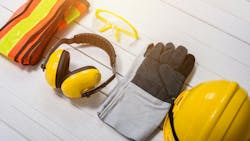When someone dies from electrocution or loses an eye, we can readily see that a safety failure has occurred. However, if a week goes by at your facility without so much as a paper cut, does that mean no safety failure has occurred?
Let’s consider something we deal with almost daily. We’ve all encountered them: the people who terrorize others with their aggressive driving. They tailgate with no hope of stopping in time. They weave, often forcing other drivers to brake hard. They blow past us at 90 or 100 mph. Even if by sheer luck and the attentiveness of other drivers they don’t slam into anybody, we don’t consider them safe drivers — and neither do the police or insurance companies.
We consider these people to be unsafe drivers all the time — not only when their choices result in a collision or fatality. Yet on the job, it’s common to ignore or downplay unsafe choices, behaviors, and conditions as long as nobody gets hurt. This is a mistake that inevitably results in an injury or death that would not have otherwise occurred.
For the sake of simplicity, we can sort occupational safety failures into two areas of responsibility:
- Employer failures.
- Employee failures.
Employer failures
One reason we know there’s a high incidence of employer failures is we can see the number of OSHA citations. OSHA is thinly spread across a large number of workplaces. So, it’s amazing that in the 12 months ending in September 2024, the agency cited companies for 2,888 violations of the hazard communication system (HCS) and 2,443 violations of lockout/tagout (LOTO) requirements. These were not employee violations; they were company violations.
In many smaller firms — and even in factories owned by larger firms — there simply isn’t the budget to have a dedicated safety director on staff. So it falls to the HR person or someone else as an add-on job responsibility.
For those factories, the solution is to properly allocate the budget. For the recalcitrant, the choice tends to get forced on them once they experience the expensive sting of a string of OSHA citations followed by a stern warning from their insurance company — or a hemorrhaging of key personnel who find these unsafe conditions unacceptable.
For the smaller firms, multiple solutions are available including outsourcing the expertise while assigning implementation and oversight to key managers.
Let’s go back to the dangerous driver example. If you, as the employer, think of your job as analogous to providing/managing the road system, you have a fair approximation of how to manage the workplace. For example, you need to ensure medians are in place to prevent head-on collisions (machine guards are in place and serviceable); people don’t speed, tailgate, or weave (you teach safe work practices and incorporate them into your work procedures, supervision, and company culture); and so forth.
As you perform this role, here are some ways to expose and correct hidden safety failures:
- Check your work procedures. If they are laden with dense safety warnings, the safety message is being ignored. Trim safety messages to simple verb-noun reminders, such as “verify de-energization” or “lockout breaker.” Properly trained people don’t need more than that, they just need a reminder.
- Check your training. Don’t conduct training so you can check the box; check the training to ensure people understand how to perform their work safely.
Establish a “safe harbor” for reporting unsafe acts. Employees should be able to report themselves (tell their supervisor about a near miss and ask for advice) and their coworkers (ask their supervisor to speak to person X about unsafe act Y) without fear of negative repercussions on anybody. It’s about protecting people, not punishing them. - Establish a coaching system. Each employee needs to watch out for coworkers. If Sally sees Jim performing an unsafe act, she should ask him to stop and correct it. Jim’s response to Sally should be one of gratitude. Getting this to work right is not difficult. It works smoothly when people realize their coworker is also their safety coach.
- Train supervisors in field auditing for safety. Their job isn’t to catch people not wearing their safety glasses and then write them up. Their job is to check how people are doing their work and provide safety mentoring as needed. They should do things such as occasionally sit in on a job briefing, follow along on a lockout/tagout, and stop people to ask them to explain what dangers they have identified and how they are protecting themselves.
- Look for system issues/unsafe conditions. These include poorly maintained lifts, damaged ladders, and incorrectly stored solvents. This should be done systematically. At a manufacturing plant in central Tennessee, the safety director does a safety inspection tour every Tuesday with a maintenance or production supervisor joining him. On a paper mill construction project in South Carolina, the safety director visited one work area every few days and supplemented his visual inspection by asking workers about safety concerns they encountered. He could often be heard saying things like, “Tell me how to make this portable cord safe.”
- Correct chronic failures. People make mistakes, and you have to allow for that by not automatically going down the formal discipline path. Often, a mistake means management did not do a good job of training. But some people either disregard the safety practices or are too unfit for work (sleep-deprived, hungover, or sick) to give safety proper attention. These people are a danger to themselves and others. The formal discipline practice must be applied to them.
Employee failures
OSHA puts the legal burden on the employer, not the employee. But that doesn’t mean the employee has no responsibility. OSHA holds the employer responsible for establishing a program to train and oversee employees.
NFPA 70E, by contrast, focuses on what employees need to do. Much of the text has to do with personal awareness, personal judgment, and personal responsibility.
If you are an employee, you have a huge incentive to work safely. Blaming the company after you lose an eye is not quite as good for you as working in such a way that you don’t lose your eye. Your primary duty on the job is to be your own personal safety supervisor. Getting the work done is extremely important, but it comes third on the list (protecting the environment, for example, not pouring solvent down the drain, is second). You must work safely — and there is no excuse for doing otherwise. Follow these tips to succeed:
- Actively address causes of inattention. Staying up too late, texting while working, and engaging in social chatter are obvious ones.
- Ask for a printed copy of your company’s electrical safety program. Read it methodically and jot down any questions you have. The only stupid question is the one you don’t ask. Where safety is concerned, the question you don’t ask might be a lethal one. So ask.
Thoroughly read and understand NFPA 70E. If you do not own a copy that you can pore over and mark up, why not buy one? - Obtain a written copy of your company’s HCS program. Take the time to understand it. If you have questions, ask your supervisor.
- Pay close attention during a job briefing. If anything is unclear, ask for clarification.
- If you are unsure about whether something is safe for you to do, don’t do it. Raise the issue with your supervisor. Note that just because it is safe for another person to do it, that doesn’t mean it’s safe for you to do it. The other person may be a “qualified person” while you are not, and that can make a critical difference.
- Don’t try to hide a safety failure from your supervisor. Instead, raise the issue and discuss how you could have done things differently. This approach shows maturity and trustworthiness — two characteristics highly valued by employers.
- Be a safety nut. If it’s been a while since someone has joked that you’re paranoid, it could mean you’re not diligent enough.
- Be methodical. To the uninitiated, a methodical work approach seems slow and inefficient. To the experienced, it is the best way to avoid mistakes, reduce waste, stay safe, and produce the highest quality of work.
No longer hidden
Make a point of learning what you can do to prevent safety failures. Watch for them to happen, determine the cause, and solve for that cause. A safety failure that doesn’t occur never becomes a reportable safety incident. But one that stays hidden will repeat itself and eventually produce serious injuries or death.
About the Author

Mark Lamendola
Mark is an expert in maintenance management, having racked up an impressive track record during his time working in the field. He also has extensive knowledge of, and practical expertise with, the National Electrical Code (NEC). Through his consulting business, he provides articles and training materials on electrical topics, specializing in making difficult subjects easy to understand and focusing on the practical aspects of electrical work.
Prior to starting his own business, Mark served as the Technical Editor on EC&M for six years, worked three years in nuclear maintenance, six years as a contract project engineer/project manager, three years as a systems engineer, and three years in plant maintenance management.
Mark earned an AAS degree from Rock Valley College, a BSEET from Columbia Pacific University, and an MBA from Lake Erie College. He’s also completed several related certifications over the years and even was formerly licensed as a Master Electrician. He is a Senior Member of the IEEE and past Chairman of the Kansas City Chapters of both the IEEE and the IEEE Computer Society. Mark also served as the program director for, a board member of, and webmaster of, the Midwest Chapter of the 7x24 Exchange. He has also held memberships with the following organizations: NETA, NFPA, International Association of Webmasters, and Institute of Certified Professional Managers.
